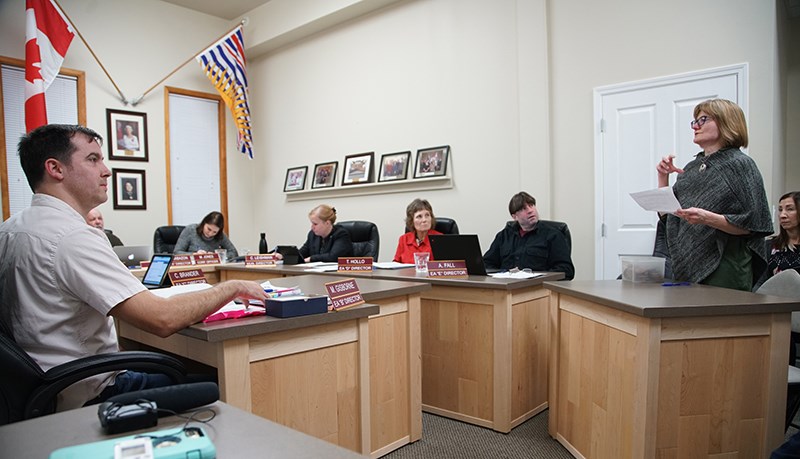qathet Regional District will conduct a study into delivering water to residents south of town by connecting to city water sources.
At the regional board meeting on Thursday, November 28, regional directors heard from residents in the affected area and deliberated on two motions regarding the regional water supply system study.
At the beginning of the meeting, regional district resident Kim Barton-Bridges said she was appearing as a delegation to ensure safe, reliable drinking water and was in support of the motion that would be before the board regarding the water study and exploration of a regional water transmission line that connects to city water from the city limits to Centennial Drive.
Barton-Bridges said there have been many water issues in this area, including arsenic, and people are concerned about infiltration into wells from their septic systems. She said Haslam Lake is a known and proven water source. Economics of constructing another water treatment plant elsewhere does not make those options viable, she added.
Barton-Bridges said she was open to sitting on a committee if the regional district wanted to structure one. She said a number of homeowners in the area are happy to help out.
“We don’t want to wait for a crisis,” said Barton-Bridges. “In the interest of growing the economy, it’s important to show people coming to Powell River that we have water. We live in a place where water is readily available. I really appreciate your consideration and hope you hear that we support what you are doing.”
Electoral Area B director Mark Gisborne asked why city water should be the only source of water in the study for this area along the highway.
“Why do you support taking West Lake off the table?” he said.
Barton-Bridges said Haslam Lake is proven, it’s working and there is water available.
“It’s there and it’s ready to go,” she said. “We’re 1,400 metres from the water so it makes sense.”
Gisborne asked what qualifications she had and if she was a hydrological engineer. Regional district chair Patrick Brabazon asked for a little more respect for the public and said that’s a loaded question.
Gisborne said he was wondering what the qualifications were for taking West Lake off the table. He said there was a 2009 study from a hydrological engineer including West (Hammil) Lake as a water source and he is not a hydrological engineer so he cannot make that call.
Brabazon called for order and said Barton-Bridges was not in attendance to discuss West Lake.
“If you have a question regarding her presentation, then that’s in order, otherwise, no,” said Brabazon.
Gisborne said she was in attendance to talk about the motion and the motion was about West [Hammil] Lake.
“She’s here to talk about water, period,” said Brabazon.
City director George Doubt said he was under the impression from her presentation that Barton-Bridges was before the board to discuss the prospect of a study of a new water supply, connecting possibly to the city, going ahead. Barton-Bridges agreed with the statement.
The board then heard from Richard Berry, who lives in Myrtle Estates. He said his water is supplied by the well maintained by the regional district and he has good water. He said his main concern was that people down in the Traff Road area and all along the highway have difficult conditions to deal with. He said some residents were struggling to have decent water.
“Regardless of where the water comes from, we are here tonight to try and make sure the people south of town have good water,” said Berry. “Where it comes from is probably an economic decision, which is why you are here. Water is a right and if we as taxpayers have an opportunity for our neighbours to have good water, we need to seriously consider it.”
Gisborne said the exercise was to get good, clean, potable water to the residents, whether it comes from the city, West Lake, Lois Lake or other sources.
“That’s an economic decision we have to discuss as a board,” said Gisborne.
When the motion came up for a vote, Gisborne said he was not voting against doing the study and he was not voting against taking the city water off the list of options to consider.
“I vote against removing West (Hammil) Lake as a source of water from the scope of this study,” he said.
Area C director Clay Brander said he had read the 2009 water study Gisborne had been alluding to and he did not think the scope of the proposed water study needed to include Hammil Lake.
Gisborne said the reason why he was so concerned was that he wanted to ensure the most cost-effective option for providing water to this service area. He said if the board does not answer the question of whether it is more effective to take the water from Hammil Lake or from the city, then the regional district is no further ahead and is spending money without finding the answer to that question.
“In 2009, the engineer said take the water from Hammil Lake,” said Gisborne. “Now, we are saying no, we are going to ignore you; we are just going to look at the city source. That is doing a disservice to the public. This is a feasibility study. Let’s look at the most cost-effective option.”
The regional board carried a motion that the board remove well W-93 in the Myrtle water system and Hammil Lake as potential sources in the regional water supply system study scope, with Gisborne opposed.
The board then carried a motion that staff be directed to negotiate with Associated Engineering (BC) Ltd. in response to the regional water supply system study request for proposal, with Gisborne opposed.



